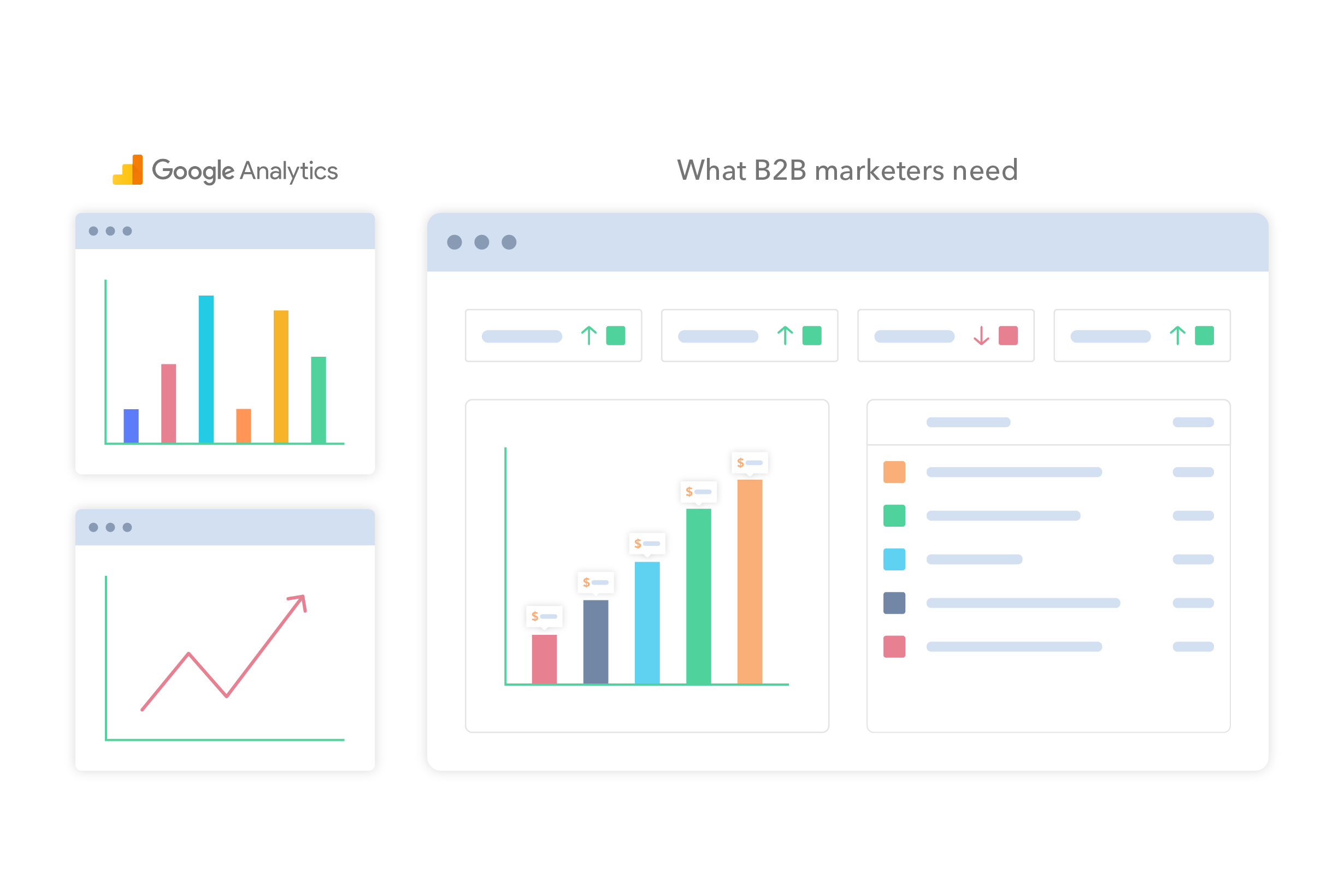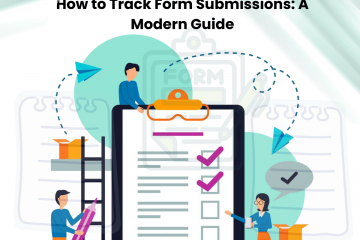Google Analytics is not enough for B2B marketers to identify winning strategies.
Google Analytics is the go-to analytics tool for all companies that analyze website and campaign data. Over 30 million websites in the world use Google Analytics. It is used by both B2B and B2C companies. And, there is no reason not to. The data provided by Google is unmatched and on a statistical level, it can show you what you need to know. But, for B2B marketers, statistics are not enough. B2B marketers need analytics on an individual level as B2B leads tend to have a higher value. So leads are dealt with as individuals instead of mass groups. Also, Google Analytics is a complicated tool to use. It might take you a lot of head-scratching to get to the data you need.

B2B businesses need software that helps them answer questions about individual leads and companies, put two and two together, and manage leads and customers. Questions like:
- Where are my leads coming from?
- What are they doing on my website?
- Do they match my target customer profile?
- Which industry and company type do they belong to?
- How can I map an individual session to related data?
- Which leads should I prioritize?
- Which campaigns are bringing the highest quality leads?
- Which campaigns are not generating good results?
- How can I use the data to influence the sales process?
Getting a 360-degree view of marketing
When we interviewed our customer, Jan Donmez from Appybee, one of the main things he mentioned is getting a real grip on marketing and having access to the right data. “ Of course you have analytics… but you need to have studied academics and whatever, to really understand what’s happening there. We wanted to have all the information we were actually looking for… a 360-degree customer journey,” he said. This is especially important for managers, executives, or those who have to outsource from a third party. Let’s take an SEO company for example. You hire an agency and they reach out to businesses and build links for you. At the end of the day, they will provide you data on how many links they built, where the links came from, and what metrics do those sites have.
This data is important as proof of work and no company can guarantee rankings but this is not the most important thing you need. What you need to know is how the campaign has impacted your organic positioning, how it has increased your traffic, and what value does the traffic brings to you. If an SEO campaign brings more organic traffic to your business but the traffic does not convert, it means your campaign has failed despite the SEO company doing their job correctly. This applies to your entire marketing system. You need a holistic view of leads, data, and operations. And, that is what Salespanel provides. Everything gets tracked and you are easily able to segment leads and companies or generate reports on each marketing campaign. Get a bird’s eye view of everything happening in marketing and optimize to improve results.
Defining necessary data and metrics

Here is a graph from a study conducted by Spiceworks that represents different metrics that are valued by marketing professionals and business leaders. You will notice that the most important metrics for marketers are lead metrics, revenue metrics, and conversion metrics. This data is for both B2B and B2C companies. For B2B marketers, let’s have a look at some of the most important metrics:
Volume metrics: Impressions, clicks, sign-ups, page visits, email opens, downloads, and everything you can think of in terms of volume. An analytics tool combined with the information provided by the publishing or advertising platform can bring you all of this information on a statistical level. But, can it tell you information about specific cohorts, groups, or types of customers? For example, can it tell you how many medium-sized companies have onboarded team members? Or, the correlation between different marketing channels and the quality of leads?
For B2C, sales cycles are shorter and the surface level metrics are sufficient (although many B2C companies are now looking at more data). B2B marketers need data on individual customer levels to truly get the insights they need.
Salespanel provides you the volumetric data you need for your visitors, leads and customers.
Conversion Metrics: There are several levels of conversions in a B2B funnel and each mark a specific milestone. In a traditional B2C system like ecommerce, a conversion is usually marked as a purchase. Some companies also consider adding to cart as a conversion step. For B2B, the conversion milestones can be signing up, booking a demo, qualifying as MQL, qualifying as SQL and finally the purchase. While marketing can get conversion data including signing up, booking demo, and qualifying leads as MQLs from their end, they need to establish data sync with sales to get information on SQLs and purchases. This effectively accomplishes closed-loop marketing. Use Salespanel to track all marketing conversion points and also get data from your sales team on sales conversion points in real-time.
Velocity Metrics: Velocity metrics help you monitor the speed of each process or conversion. How long does it take for a visitor to sign up? How long does it take to perform a key action? How long does it take for them to become marketing qualified? How long does it take for them to become sales qualified? How long does the sales cycle last? What is the correlation with business size or industry? Do higher ticket deals have a longer sales cycle? How does the information help? To answer these questions, create reports and monitor velocity data across different time periods.
Identifying winning campaigns
Once you set up proper analytics and reporting, it is time to identify your winning campaigns and your losing campaigns. The further you can break the data down and join the dots, the more effective your strategy is going to be. Let’s take an example. You have three lead generation strategies in place: Google search advertising, Facebook display campaigns, and outreach campaigns. Now, when digging deeper using our data, you find that Google search ad campaigns are performing the best. Digging further, you are able to find out that there are a handful of keywords that are bringing the most valuable leads. What you can do next is amplify the budget for these keywords. You can even increase the bid to increase the volume if the ROI is high. Similarly, you can find out other successful campaigns and eliminate campaigns with poor results. Follow the 80-20 strategy and relocate your budget to real winners.
Using data for lead prioritization, nurturing and automation
B2B businesses often prioritize deals that have higher weightage and work on qualifying leads before they are sold to. Like we have mentioned before, leads go through the marketing qualification process and the sales qualification process. As a marketer, your job is to leverage all marketing analytical data to qualify your leads and move them through the buying process. The data that helps you generate reports and analyze marketing performance also helps you prioritize your best prospects.
Use segmentation or lead scoring and progressively qualify your leads before moving to sales. Sales can then take the deal further and close.
Lead management and nurturing is another crucial aspect of marketing. Marketing uses the data to analyze customer cohorts and behavior and serve highly targeted content and advertising. You can create various automated triggers and sequences based on lead profile or actions.
Creating real-time data sync with sales for closing the loop
I have mentioned before how closing the loop is crucial for B2B marketing analytics. The data you get from sales is crucial to understand how MQLs react after going further in the buying process and you can also find out how leads are converting, how much time it takes to close deals with respect to the customer profile, which marketing campaigns are bringing the most closed deals, which customers are churning, etc. By creating data sync with sales, all of the sales and post-sales data can be synced back to marketing. As the loop closes, data can be analyzed more efficiently.
Salespanel is a multi-functional marketing tool where you can get access to data easily without needing to be a complex analytics ninja. Identify and mitigate problems, improve your campaigns and your funnels and create a better marketing structure for your business.
Sell more, understand your customers’ journey for free!
Sales and Marketing teams spend millions of dollars to bring visitors to your website. But do you track your customer’s journey? Do you know who buys and why?
Around 8% of your website traffic will sign up on your lead forms. What happens to the other 92% of your traffic? Can you identify your visiting accounts? Can you engage and retarget your qualified visitors even if they are not identified?


